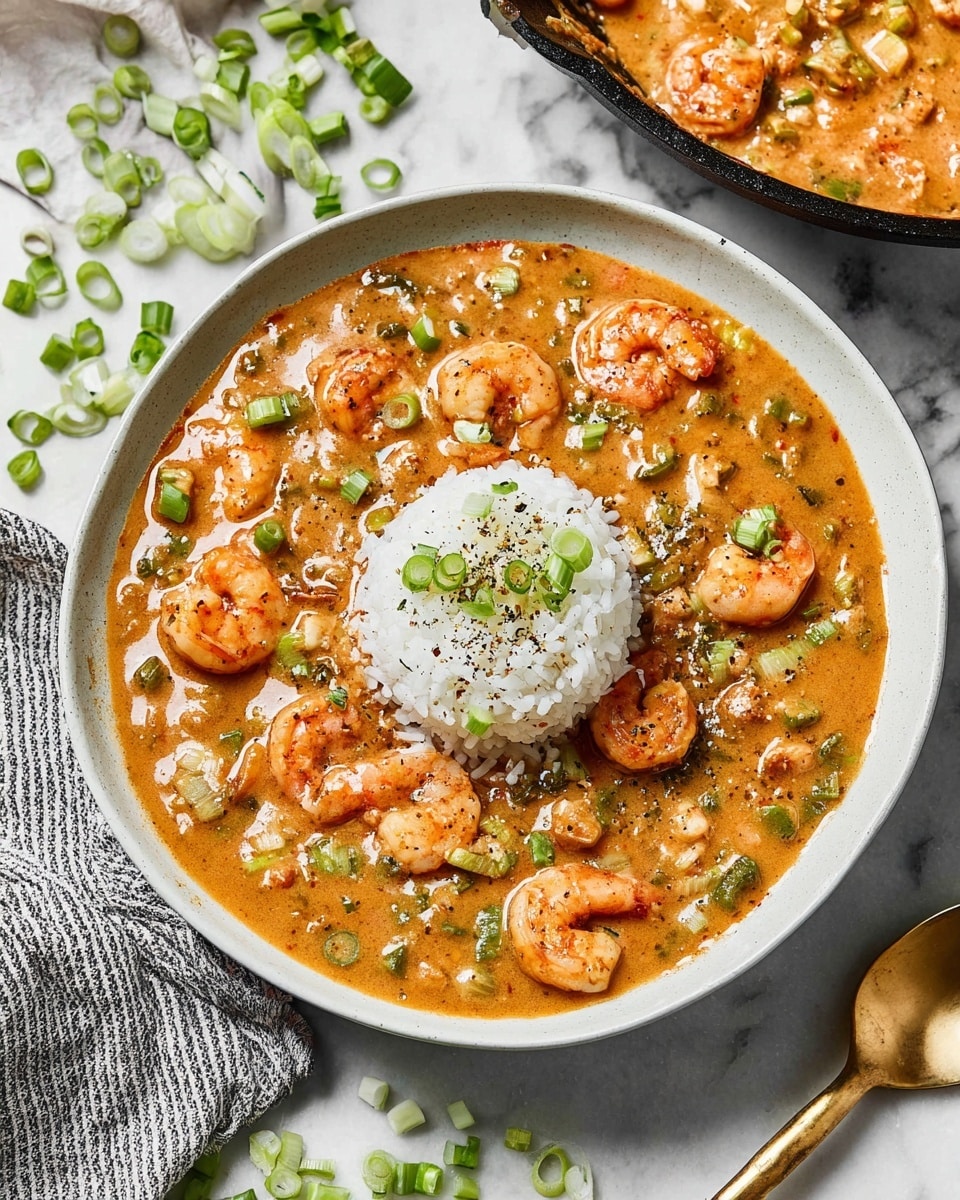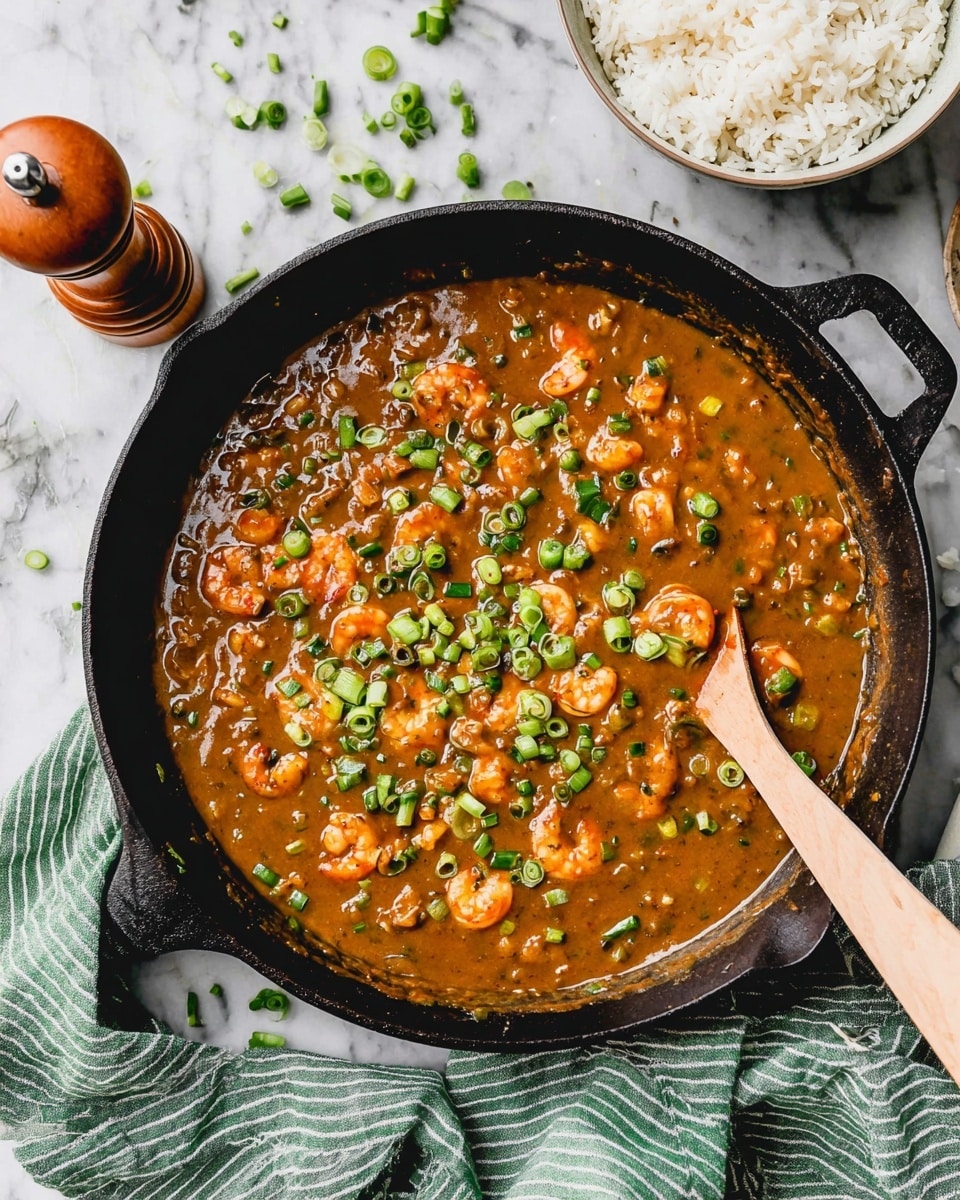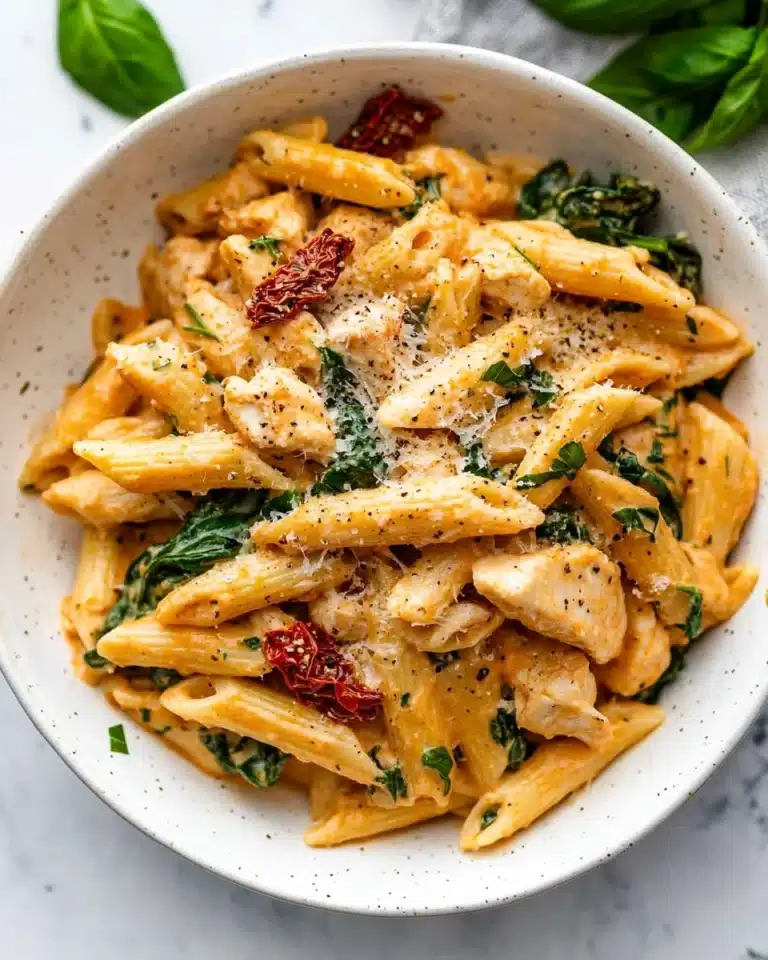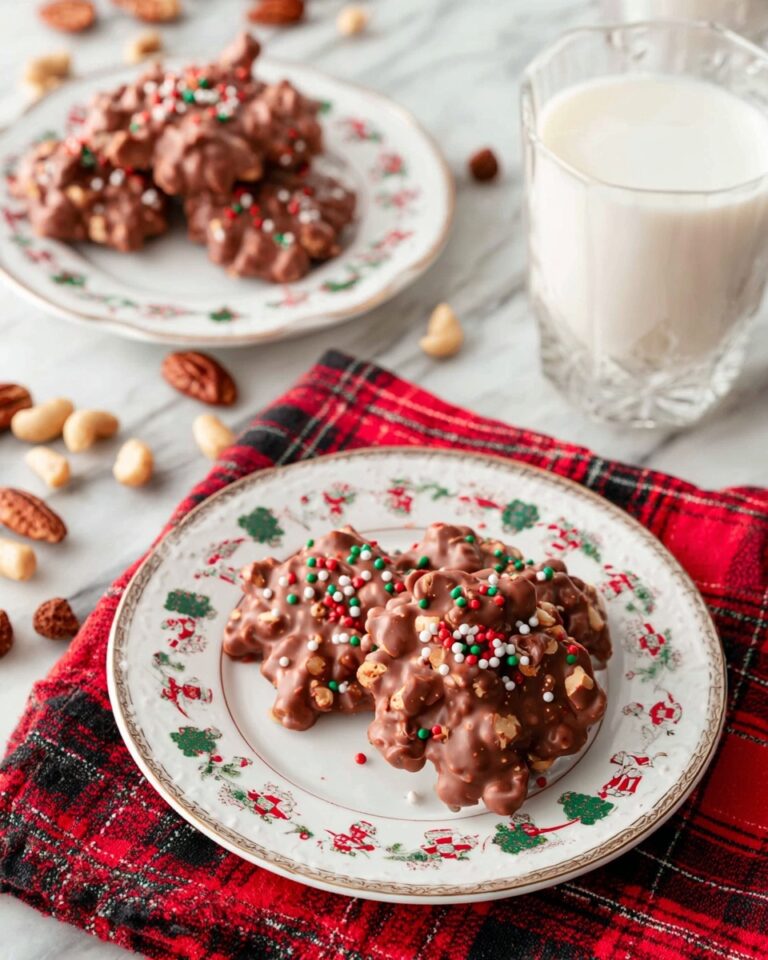If you’re craving something that’s bursting with rich, comforting flavors and a little Louisiana soul, you’re in the right spot. This Crawfish Étouffée Recipe is one of my all-time favorites because it’s cozy enough for weeknights but special enough to impress guests. You’ll love how the crawfish tails are gently simmered in a creamy, velvety sauce that’s perfectly spiced and served over fluffy rice. Trust me, once you make this, it’ll become a staple in your kitchen rotation.
Why You’ll Love This Recipe
- Authentic Cajun Flavors: This dish captures the essence of Louisiana cooking with its perfect blend of spices and the holy trinity of veggies.
- Comfort Food at Its Best: Creamy, savory, and warming, it’s exactly what you want on a chilly evening or for a relaxed family dinner.
- Simple Yet Impressive: You don’t have to be a pro to make this—just a little patience and good ingredients will do the trick.
- Versatile Serving Options: Whether you prefer rice or grits, this recipe adapts beautifully to your taste and what’s in your pantry.
Ingredients You’ll Need
Each ingredient plays a starring role in this Crawfish Étouffée Recipe. I always recommend using fresh veggies and good-quality seafood stock because they really make the sauce shine. Plus, if you find Louisiana crawfish tails, grab ’em—you’ll thank me later!
- Yellow onion: This brings sweetness and rounds out the spicy flavors once sautéed with the other veggies.
- Green bell pepper: Part of the Cajun holy trinity; gives the dish a fresh, slightly grassy crunch before it softens.
- Celery: Adds aromatic depth and builds that classic Cajun foundation you’ll taste in every bite.
- Garlic: Minced fresh garlic amplifies the savory notes beautifully in this dish.
- Butter: Divided usage here—some for sautéing and a bigger amount to create that luscious roux that thickens the sauce.
- All-purpose flour: The key to making the roux that gives étouffée its signature velvety texture.
- Seafood stock: You want a rich, flavorful broth; homemade or store-bought works fine, but avoid anything too salty.
- Better than bouillon lobster base: Elevates the seafood flavor; it’s my secret boost without overpowering the crawfish.
- Cajun seasoning: Adds a nice kick; feel free to adjust based on your spice preference.
- Kosher salt: To balance everything just right.
- Freshly ground black pepper: For a little warm spice and complexity.
- Dried thyme: A subtle herbal note that rounds out the seasoning.
- Cayenne pepper: Adds that essential heat—start small and add more if you like it spicier.
- Green onions: Fresh chopped for garnish and a little extra crunch and freshness at the end.
- Louisiana Crawfish tails: Make sure they’re peeled and cleaned; yours might be fresh or frozen, both work.
- Hot cooked rice or grits: The perfect base to soak up all that delicious sauce.
- Hot sauce (optional): I’m a Crystal fan—adds a nice tang and heat at the table.
Variations
What I really enjoy about this Crawfish Étouffée Recipe is how easy it is to make your own. I’ve tried switching up the spice levels and even the seafood, and each time it’s a delicious twist. So, feel free to personalize it to suit your cravings or dietary needs.
- Shellfish swap: Sometimes I swap crawfish for shrimp or crab when fresh crawfish aren’t available; it still gives great flavor.
- Vegetarian option: Use vegetable stock and mushrooms instead of seafood for a veggie-friendly twist.
- Spice it up or down: Adjust the cayenne and Cajun seasoning to your heat tolerance—you can easily make it mild or fiery.
- Roux color variation: For a nuttier flavor, let your roux get a little darker, but be careful not to burn it!
How to Make Crawfish Étouffée Recipe
Step 1: Sauté Your Holy Trinity Veggies
Start by melting 3 to 4 tablespoons of butter (or a neutral oil if you prefer) in a large cast iron skillet or Dutch oven over medium heat. Once it’s shimmering, toss in the diced onion, celery, bell pepper, and minced garlic. Cook these for about 5 minutes until they’re tender and translucent—that’s when all the flavors really start to develop. I like to stir occasionally to make sure nothing sticks or browns too much. When they’re just right, scoop them out into a bowl and set aside for later.
Step 2: Craft the Perfect Roux
Turn your heat down to medium-low and add 8 tablespoons (that’s one full stick) of butter to the same pan. When it’s melted and bubbling, sprinkle in your all-purpose flour and whisk constantly. This part takes some attention—you’re going to cook and stir your roux for about 10 to 15 minutes. You want it to turn the color of peanut butter, a golden brown that gives the sauce its signature nutty depth. Be patient here! If you rush or stop whisking, you risk burning it and getting a bitter taste. I always keep a close eye and keep that whisk moving.
Step 3: Finish the Sauce
Reduce the heat to low. Slowly add your seafood stock bit by bit, whisking constantly to keep the mixture smooth and lump-free. It’s key to pour it in a slow, steady stream—that’s how you get that beautifully silky gravy consistency. Once all the broth is incorporated, add back your sautéed veggies, the Cajun seasoning, Better than Bouillon lobster base, kosher salt, black pepper, thyme, and cayenne pepper. Let everything simmer gently for about 10 minutes. If the sauce feels too thin, there’s a little trick I discovered: mix a spoonful of broth with an extra tablespoon or two of flour in a cup until smooth, then stir that back into the pot and cook until thickened. It’s foolproof.
Step 4: Add the Crawfish Tails and Warm Through
Gently fold in your crawfish tails and let them warm through for a few minutes—be careful not to overcook or they’ll get rubbery. Give the sauce one last taste and tweak the salt or spice if it needs a little boost. At this point, your Crawfish Étouffée Recipe is nearly ready to serve!
Step 5: Serve It Up
Ladle your étouffée over a steaming scoop of hot rice or creamy grits—whatever you prefer. Garnish with plenty of chopped green onions, and if you’re like me, offer hot sauce on the side for that extra kick. This dish is pure comfort from the first bite to the last.
Pro Tips for Making Crawfish Étouffée Recipe
- Keep the Roux Moving: I learned the hard way that stirring constantly while making your roux prevents burning and gives that perfect nutty flavor.
- Use Quality Stock: When I switched to using a better seafood broth, the flavor elevated so much—it really makes all the difference.
- Don’t Overcook Crawfish: They just need a quick warm through to stay tender and juicy.
- Adjust Thickness Carefully: If your sauce is too thin, add flour gradually to avoid lumps instead of dumping it all at once.
How to Serve Crawfish Étouffée Recipe

Garnishes
I always finish my Crawfish Étouffée Recipe with a generous sprinkle of fresh green onions. They add that bright color and fresh bite that balances the richness of the sauce. Plus, a few dashes of your favorite hot sauce at the table never hurt—Crystal hot sauce is my go-to because of its perfect blend of tang and heat.
Side Dishes
This étouffée is hearty on its own, but pairing it with a crisp green salad or some garlic bread really rounds out the meal. My family loves cornbread muffins alongside; the slightly sweet, buttery bread contrasts beautifully with the spicy, savory sauce.
Creative Ways to Present
I’ve served this in hollowed-out mini bell peppers to make a fun appetizer for parties, which always gets compliments. Another idea that’s fun for special occasions is plating the étouffée alongside Cajun-spiced roasted vegetables or stuffing it over creamy grits for a Southern-style twist.
Make Ahead and Storage
Storing Leftovers
I usually let the étouffée cool completely before transferring it to an airtight container. It keeps really well in the fridge for up to three days. When reheating, I like to warm it gently on the stove with a splash of broth or water to bring back that creamy consistency.
Freezing
While I recommend enjoying this fresh, étouffée freezes surprisingly well. Freeze it in a sealed container for up to two months. When thawing, do so overnight in the fridge and reheat slowly on the stove. Just be mindful that the sauce might thicken a bit, so stir in extra broth if needed to loosen it.
Reheating
To reheat, use low heat on the stovetop or microwave in short bursts to avoid overcooking the crawfish. Stir often and add a splash of seafood stock or water if the sauce gets too thick. This helps maintain that perfect texture and flavor we all love.
FAQs
-
Can I use frozen crawfish tails in this recipe?
Absolutely! Frozen crawfish tails work great and are often more accessible. Just thaw them completely before adding to the sauce to ensure they warm through evenly without overcooking.
-
What can I substitute if I don’t have seafood stock?
If you don’t have seafood stock, you can use chicken stock or vegetable stock combined with a bit of seafood bouillon or lobster base to keep the rich flavor profile close to the original.
-
How spicy is this Crawfish Étouffée Recipe?
It has a mild to moderate heat level thanks to the cayenne pepper and Cajun seasoning, but you can easily adjust the spice according to your taste by adding more or less cayenne and serving with hot sauce on the side.
-
Can I make this dish ahead of time?
Yes! You can prepare the étouffée a day ahead and store it in the fridge. Reheat gently on the stove and add a splash of broth if needed to refresh the texture right before serving.
Final Thoughts
I absolutely love how this Crawfish Étouffée Recipe comes together—each step building up those rich Louisiana flavors that feel like a warm hug on a plate. When I first tried making étouffée myself, I was nervous about the roux, but now it’s my proudest kitchen accomplishment. If you’ve been looking for a recipe that captures the heart of Cajun cooking without being intimidating, this is it. So grab those crawfish tails, fire up your stove, and enjoy sharing this with friends and family—I promise, you’re going to make some serious fans!
Print
Crawfish Étouffée Recipe
- Prep Time: 15 minutes
- Cook Time: 40 minutes
- Total Time: 55 minutes
- Yield: 7 servings
- Category: Main Dish
- Method: Stovetop
- Cuisine: Cajun
Description
A classic Louisiana Crawfish Étouffée featuring tender crawfish tails simmered in a rich, flavorful holy trinity vegetable roux-based sauce, served over steaming hot rice or grits. This hearty Cajun dish balances savory, spicy, and buttery notes, perfect for a comforting authentic Southern meal.
Ingredients
Vegetables
- 1 yellow onion, diced
- 1 green bell pepper, diced
- 2 ribs celery, diced
- 5 cloves garlic, minced
- 1 bunch green onions, chopped
Roux & Sauce
- 12 tablespoons butter, divided
- 1/2 cup all-purpose flour
- 4 cups seafood stock (or a little more as needed)
- 2 teaspoons Better than Bouillon lobster base
- 1 teaspoon Cajun seasoning
- 1/4 teaspoon kosher salt
- 1/2 teaspoon freshly ground black pepper
- 1/4 teaspoon dried thyme
- 1/4 teaspoon cayenne pepper (ground, or more to taste)
Main & Serving
- 1 lb Louisiana crawfish tails
- 4 cups hot cooked white rice (or grits)
- Hot sauce (such as Crystal), for serving
Instructions
- Sauté “Holy Trinity” Veggies: In a 12-inch cast iron skillet or Dutch oven over medium heat, melt 3 to 4 tablespoons of butter. Add the diced onion, celery, bell pepper, and minced garlic. Cook for about 5 minutes until the vegetables are translucent. Remove the cooked vegetables and set aside in a bowl.
- Make the Roux: Reduce the heat to medium-low and add the remaining 8 tablespoons (1 stick) of butter to the pan. Once melted, whisk in the flour. Continuously whisk and cook the mixture for 10-15 minutes until it reaches a golden, peanut butter color, being careful not to let it burn.
- Finish the Gravy: Lower the heat to low. Slowly pour in the seafood stock while whisking constantly to achieve a smooth consistency. Return the sautéed vegetables to the pot. Stir in the lobster base, Cajun seasoning, kosher salt, black pepper, dried thyme, and cayenne pepper. Simmer gently for 10 minutes until the sauce thickens to a gravy-like consistency. If the sauce needs thickening, mix 1-2 tablespoons of flour with a spoonful of broth separately, then stir it back into the pot and cook until thickened.
- Add Crawfish: Stir in the Louisiana crawfish tails and cook just until warmed through. Taste and adjust the seasonings as desired.
- Serve: Spoon the crawfish étouffée over hot cooked white rice or grits. Garnish with chopped green onions and offer hot sauce on the side for added heat.
Notes
- This recipe is a traditional Louisiana étouffée with a focus on fresh crawfish and rich roux-based sauce.
- Seafood stock can be substituted with shrimp or fish stock, homemade or store-bought.
- Adjust the cayenne pepper according to your preferred heat level.
- If grits are preferred over rice, ensure they are cooked hot and creamy for the best pairing.
- Use a heavy-bottomed pan, like cast iron or Dutch oven, to prevent roux from burning.
Nutrition
- Serving Size: 1 serving
- Calories: 370 kcal
- Sugar: 2 g
- Sodium: 837 mg
- Fat: 21 g
- Saturated Fat: 13 g
- Unsaturated Fat: 6 g
- Trans Fat: 1 g
- Carbohydrates: 37 g
- Fiber: 2 g
- Protein: 8 g
- Cholesterol: 62 mg









